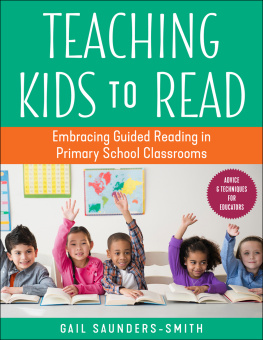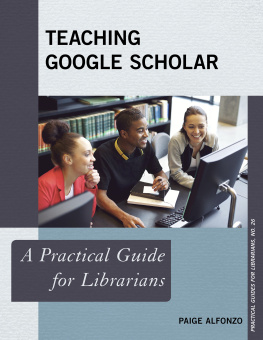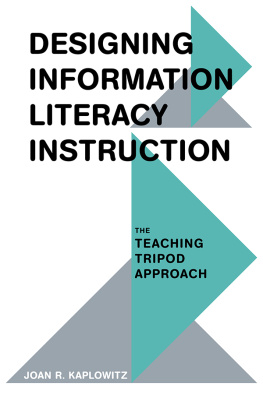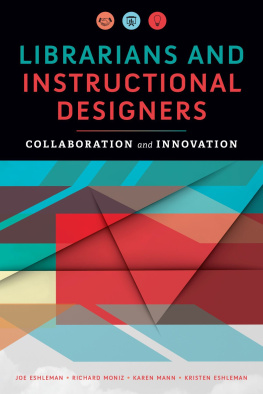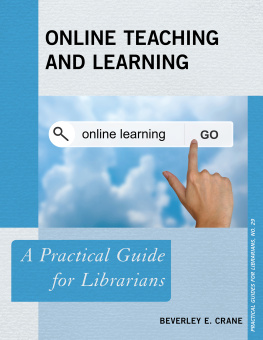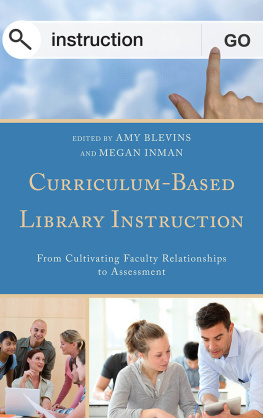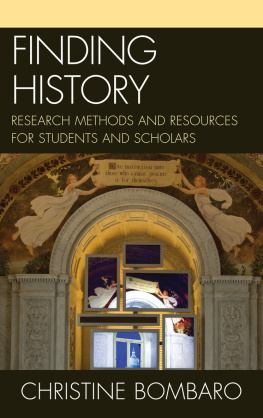Using Primary Sources
Hands-On Instructional Exercises
Anne Bahde
Heather Smedberg
Mattie Taormina

Copyright 2014 by Anne Bahde, Heather Smedberg, and Mattie Taormina
All rights reserved. No part of this publication may be reproduced, stored in a retrieval system, or transmitted, in any form or by any means, electronic, mechanical, photocopying, recording, or otherwise, except for the inclusion of brief quotations in a review, without prior permission in writing from the publisher.
Library of Congress Cataloging-in-Publication Data
Using primary sources : hands-on instructional exercises / Anne Bahde, Heather Smedberg, and Mattie Taormina, editors.
pages cm
Includes bibliographical references and index.
ISBN 978-1-61069-434-6 (pbk.) ISBN 978-1-61069-435-3 (e-book) 1. ResearchMethodologyStudy and teaching (Higher) 2. ResearchMethodologyStudy and teaching. 3. HistorySourcesStudy and teaching. 4. Information literacyStudy and teaching. 5. Visual literacyStudy and teaching. 6. LibrariesSpecial collections. 7. Archives and education. 8. MuseumsEducational aspects. 9. Academic librariesRelations with faculty and curriculum. I. Bahde, Anne, editor of compilation. II. Smedberg, Heather, editor of compilation. III. Taormina, Mattie, editor of compilation.
ZA3075.U84 2014
001.42071dc23 2013044427
ISBN: 978-1-61069-434-6
EISBN: 978-1-61069-435-3
18 17 16 15 14 1 2 3 4 5
This book is also available on the World Wide Web as an eBook.
Visit www.abc-clio.com for details.
Libraries Unlimited
An Imprint of ABC-CLIO, LLC
ABC-CLIO, LLC
130 Cremona Drive, P.O. Box 1911
Santa Barbara, California 93116-1911
This book is printed on acid-free paper 
Manufactured in the United States of America
Contents
Elizabeth Yakel
Joanne Archer
Kelli Hansen
Leah Hoblit and Lisa Sjoberg
Maggie Kopp
Lauren Silver
Heather Smedberg
Jenny Swadosh
Anne Bahde
Anne Bahde
Jason A. Bocko
Erika Boeckeler, Michelle Romero, and Amanda Rust
Peter Carini
Christine de Catanzaro, Wendy Hagenmaier, Mandi Johnson, and Jody Lloyd Thompson
Lori Dekydtspotter and Cherry Dunham Williams
Erin Dix
Prudence Doherty
Julie Golia and Robin M. Katz
Will Hansen
Sean Heyliger and Juli McLoone
Barbara Hochman
Sarah M. Horowitz
Gregory Kocken
Rebecca Larson-Troyer
Melissa Nykanen
Jay Satterfield
Lisa Schoblasky and Autumn Mather
Jennifer K. Sheehan
Heather Smedberg
Mattie Taormina
Mattie Taormina
Foreword
Elizabeth Yakel
Associate Dean and Professor, University of Michigan, School of Information
Letting Loose among the Archives
In his 1971 Society of American Archivists (SAA) presidential address, Hugh Taylor (1972) argued for more student engagement with primary sources. He implored archivists and special collections librarians to collaborate with teachers to identify ways in which students could be let loose among the archives (330). Over the past 40 plus years, archivists and special collections librarians have heeded Taylors impassioned plea to engage students with the collections. Professional discussions have shifted from whether students should be allowed into the repository and exposed to primary sources to what are the most effective pedagogical strategies, learning objectives, and activities for different audiences.
I have long been interested and written about learning in the archives and special collections. Recently, my work has centered on measuring learning impacts in primary sources instruction. When I wrote AI: Archival Intelligence and User Expertise (Yakel and Torres 2003), I found it very difficult to find information on what other archivists and special collections librarians were doing vis--vis primary sources in the classroom. They had not discussed the content, the structure, or objectives of what was then still largely referred to as archival or manuscripts orientation. The literature was dispersed and often lacked the detail necessary to replicate in another setting. Over the past decade, more authors have written about using primary sources in different educational settings; however, it is still hard to compare the curricula, and few authors publish case studies with sufficient depth to assess the actual exercises or activities employed. Anne Bahde, Heather Smedberg, and Mattie Taormina are among the more reflective archivists and special collections librarians who have written about primary sources instruction. Using Primary Sources: Hands-On Instructional Exercises fills a large gap in the literature. They are the ideal trio of editors and authors for this work: each has substantial instructional experience in the archives and special collections and has presented and written on this topic. Each has also contributed instructional exercises in this collection.
Using Primary Sources: Hands-On Instructional Exercises is required reading for any instructional archivist or special collections librarian. It is important for several reasons. First, the editors have taken a sound pedagogical approach by creating a template that links the instructional exercises to learning objectives. Therefore, an archivist or special collections librarian could work from a professors learning objectives, such as formulating research questions or how primary sources can be used as evidence, and identify different types of exercises that address specific objectives. Second, Using Primary Sources presents a broad range of exercises in terms of learning objectives, disciplines targeted, audiences (e.g., K12, undergraduate, graduate school), genre of materials on which the exercises are based (e.g., diaries, photographs), and media formats (e.g., analog and digital). Finally, the book is intended to encourage replication and adaptation. Each exercise is presented with information about preparation, logistics, and discussion questions. By collecting these together in one place, the editors have created a valuable resource for seasoned instructors as well as archivists or special collections librarians who are new to instruction.
I agreed to write this foreword because I care passionately about learning in the archives and special collections. I firmly believe that primary sources can contribute to education in unique and important ways, opening up students minds to diverse perspectives, different possibilities, and unexpected learning opportunities. Yet, for learning to occur, there must be good teaching. This is the ultimate aim of Using Primary Sources: Hands-On Instructional Exercises: to foster good pedagogy, reflective teaching practice, and sharing among peers to benchmark and ultimately improve teaching and learning around primary sources. This book represents the culmination of decades of thinking and activity around the role of the primary sources in education.
When Hugh Taylor called for conversations between archivists and special collections librarians and teachers to determine how students could be let loose among the archives, he could never have imagined the breadth of instructional approaches, topics, and learning objectives depicted in this book. In letting the students loose, Anne Bahde, Heather Smedberg, and Mattie Taormina have also shown us how to free the primary sources in order to fulfill educational goals for our collections that were unimaginable in the past.


